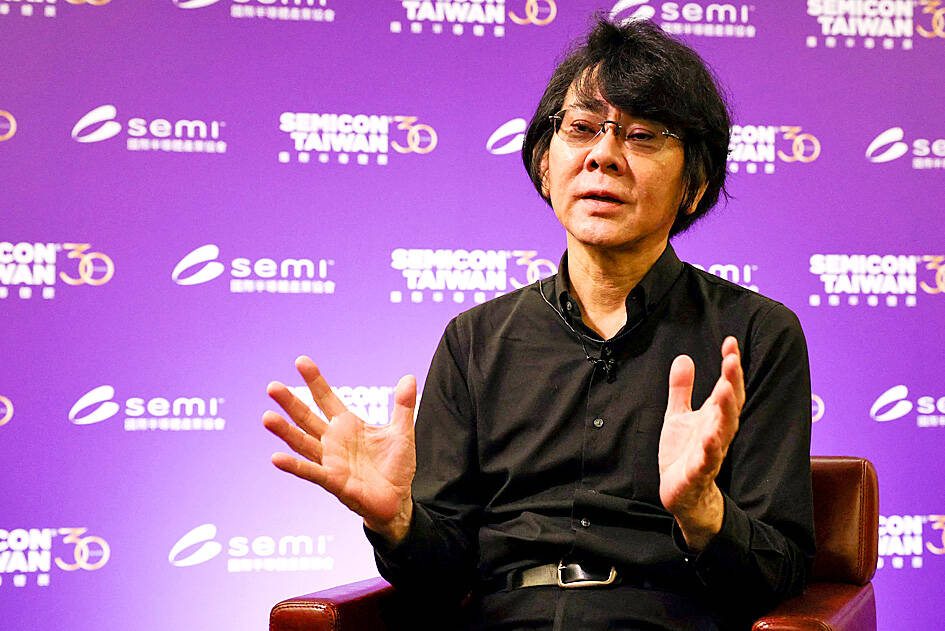Taiwan could play a key role in the humanoid robot sector by leveraging its strengths in semiconductors and key components, Japanese robotics pioneer Hiroshi Ishiguro said yesterday.
The Osaka University professor said after a presentation at the Semicon Taiwan forum in Taipei that Taiwan should focus on creating diverse applications by integrating electronics, sensors and critical parts rather than competing with China on cost.
Ishiguro said that avatar-based robot software, which allows remote interaction through virtual doubles, is likely to develop faster than full humanoid robots because of its convenience and adaptability.

Photo: Cheng I-hwa, AFP
He said that he was curious to see whether Taiwan’s industry, academia and society are as open as Japan to adopting avatar-based interactions, and did not rule out collaboration with local companies.
While artificial intelligence has made humanoid robots smarter than they were 25 years ago, Ishiguro said that applications remain limited, particularly in tasks requiring dexterity and sensory precision.
He predicted it would take another 10 years before real market demand emerges.
Market demand remains the decisive factor, he said, pointing to the eventual discontinuation of Honda Motor Co’s Asimo and Sony Group Corp’s humanoid robots due to weak commercial uptake.
Ishiguro said that Chinese humanoid robots are “significantly cheaper,” making it difficult for Taiwan and Japan to compete directly.
Building a non-China supply chain for humanoid robots would be challenging because of the high production costs in other countries, he added.
Despite the obstacles, Ishiguro said that Taiwan’s position in semiconductors and component manufacturing gives it an opportunity to shape future applications.

CHIP RACE: Three years of overbroad export controls drove foreign competitors to pursue their own AI chips, and ‘cost US taxpayers billions of dollars,’ Nvidia said China has figured out the US strategy for allowing it to buy Nvidia Corp’s H200s and is rejecting the artificial intelligence (AI) chip in favor of domestically developed semiconductors, White House AI adviser David Sacks said, citing news reports. US President Donald Trump on Monday said that he would allow shipments of Nvidia’s H200 chips to China, part of an administration effort backed by Sacks to challenge Chinese tech champions such as Huawei Technologies Co (華為) by bringing US competition to their home market. On Friday, Sacks signaled that he was uncertain about whether that approach would work. “They’re rejecting our chips,” Sacks

NATIONAL SECURITY: Intel’s testing of ACM tools despite US government control ‘highlights egregious gaps in US technology protection policies,’ a former official said Chipmaker Intel Corp has tested chipmaking tools this year from a toolmaker with deep roots in China and two overseas units that were targeted by US sanctions, according to two sources with direct knowledge of the matter. Intel, which fended off calls for its CEO’s resignation from US President Donald Trump in August over his alleged ties to China, got the tools from ACM Research Inc, a Fremont, California-based producer of chipmaking equipment. Two of ACM’s units, based in Shanghai and South Korea, were among a number of firms barred last year from receiving US technology over claims they have

BARRIERS: Gudeng’s chairman said it was unlikely that the US could replicate Taiwan’s science parks in Arizona, given its strict immigration policies and cultural differences Gudeng Precision Industrial Co (家登), which supplies wafer pods to the world’s major semiconductor firms, yesterday said it is in no rush to set up production in the US due to high costs. The company supplies its customers through a warehouse in Arizona jointly operated by TSS Holdings Ltd (德鑫控股), a joint holding of Gudeng and 17 Taiwanese firms in the semiconductor supply chain, including specialty plastic compounds producer Nytex Composites Co (耐特) and automated material handling system supplier Symtek Automation Asia Co (迅得). While the company has long been exploring the feasibility of setting up production in the US to address

OPTION: Uber said it could provide higher pay for batch trips, if incentives for batching is not removed entirely, as the latter would force it to pass on the costs to consumers Uber Technologies Inc yesterday warned that proposed restrictions on batching orders and minimum wages could prompt a NT$20 delivery fee increase in Taiwan, as lower efficiency would drive up costs. Uber CEO Dara Khosrowshahi made the remarks yesterday during his visit to Taiwan. He is on a multileg trip to the region, which includes stops in South Korea and Japan. His visit coincided the release last month of the Ministry of Labor’s draft bill on the delivery sector, which aims to safeguard delivery workers’ rights and improve their welfare. The ministry set the minimum pay for local food delivery drivers at